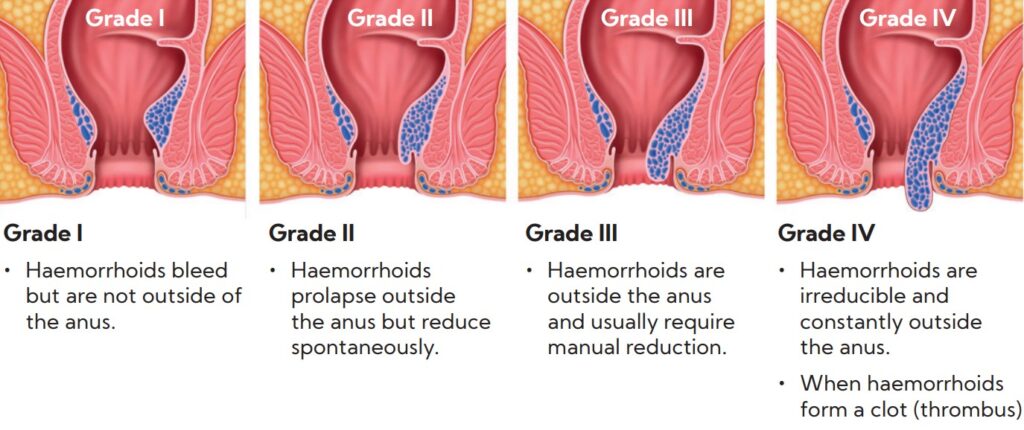Haemorrhoids, it’s a bum thing
Haemorrhoids also called piles is when the veins in the anus dilate creating an outgrowth inside the rectum or under the skin in the anus.1,2 The anus is plus minus 4 cm long in adults with a dentate line roughly located at the midpoint. Haemorrhoids that develop above the dentate line are internal and are painless. External haemorrhoids develop below the dentate line and become painful and swollen.1
Internal haemorrhoids can be graded1,3

Is it the piles?
Symptoms of internal haemorrhoids include:3
- Bright red bleeding with bowel movements
- A sense of pressure, discomfort or incomplete evacuation sometimes with rectal seepage
Symptoms of external haemorrhoids are normally painless.3
Water can make it better
- Drink six to eight glasses of water a day to help soften your stools.1,2,4
- Sitz baths can help ease the symptoms of external haemorrhoids. The mild temperature of the water boosts the blood flow, which helps with the healing process.5
Take fiber for your colon health
An increase in your fiber is one of the first-line treatments for haemorrhoids. It is recommended to consume 25 to 35 grams of fiber per day.1,4 Fiber helps improve your form, bulk and size of your stool, which contributes to colon health.4
Fiber is classified into two forms6,7
- Soluble fiber dissolves in water and forms a gel-like material
- Insoluble fiber does not dissolve in water. It helps with the movement of material through the digestive tract increasing stool bulk. This type of fiber can help when you struggle with constipation or irregular stools.
Causes of haemorrhoids include a diet low in fiber, straining during bowel movements, chronic diarrhoea and constipation.2
A diet high in fiber
A high-fiber diet increases bowel movements by increasing the weight and the size of the stool as well as softens it.6c When your stool is easier to pass it lessens the chances of constipation.6 A diet high in fiber avoids straining and maintains a healthy bowel movement, which lowers your risk of haemorrhoids.6
Oatmeal forms part of a diet high in fiber.6 It contains beta-glucans, which act as a prebiotic in the gut by adding bulk to the stool without the laxative effect.7 Beta-glucans also promote the growth of healthy gut bacteria called Bifidobacterium and Lactobacillus.8
The flavour of flavonoids
The main groups of flavonoids include:9
| GROUP | FOOD SOURCES |
|---|---|
| Flavones | Apple skin, berries, broccoli, celery, cranberries, fruit peels, grapes, lettuce, olives, onions, parsley |
| Flavanones | Citrus fruit, citrus peel |
| Anthocyanins | Berries, cherries, grapes, raspberries, red grapes, strawberries, tea, fruit with dark pigments |
The benefits of flavonoids 10

Constipation can cause haemorrhoids
You may be constipated when your visits to the bathroom become irregular, your stool is hard, dry and difficult to pass.11 Symptoms of constipation such as straining during bowel movement and a sense of pressure when passing stool can cause haemorrhoids.2
Foods with little or no fibre can cause constipation. Foods to avoid include:12
- Chips
- Fast food
- Meat
- Prepared foods e.g., frozen meals and snack foods
- Processed foods e.g., hot dogs or some microwavable dinners
Constipation can also be caused by a diet rich in dairy products and sugary sweets.13
The link between piles and IBS
Constipation, with the accompanying straining is not the only cause of piles. It has been shown that diarrhoea may also contribute to the condition. Patients with Irritable Bowel Syndrome (IBS), may often develop piles due to the fact that both these symptoms may be experienced with the condition.14
IBS is classified into 4 sub-types:15
| IBS-C | Patients struggling with predominantly constipation |
| IBS-D | Those that experience predominantly diarrhoea |
| IBS-M | Patients may struggle with both these symptoms equally |
| IBS-U | Pattern cannot be determined |
International treatment guidelines recommend 2 distinct diet adjustments to reduce IBS symptoms. Click on the links for more information on each of these diets.15
It is interesting to know that more than half of people suffering from IBS may switch between these types of IBS over a 1-year period, and may need to reconsider their diet.15
It’s all in the gut
Probiotics are live organisms such as bacteria and yeast, that are naturally present in fermented foods.16 Probiotics act mainly in the gastrointestinal (GI) tract where they play a role in your gut microbiome.16 Your gut microbiome is made up of many microorganisms (mostly bacteria) that primarily live in your large intestine.16 When you eat enough probiotics, they help protect the GI tract from harmful microorganisms, which improves your digestion and gut function. Foods to include in your diet for gut health:17
- Yoghurt
- Sauerkraut
- Tempeh
- Certain cheeses
- Kefir
- Pickles
- Kimchi
- Kombucha
- Miso
- Sourdough bread
Increasing your water intake and following a diet high in fiber, can help prevent and ease the symptoms of haemorrhoids.1

